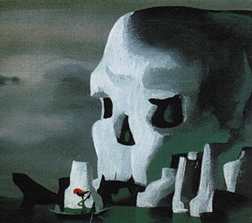The art of Mary Blair
Mary Blair
(the following was provided from the Bob Staake website)
Born on October 21, 1911 in McAlester, Oklahoma, Mary Browne Robinson graduated from the Chouinard School of Art in 1933 and soon became part of what was dubbed the 'California School of Watercolor'. Her career as a fine art watercolorist was effectively derailed by the Depression -- as well by her admiration of Walt Disney.
In 1934, Mary married Lee Blair. While both Lee and Mary worked at the Disney Studios, Walt developed an unusual affinity for Mary's artistry.
Over the next 37 years, Mary worked on and off for Disney. She is best known for her color stylings and design work in such Disney classic as 'Alice in Wonderland', 'Peter Pan', 'Saludos Amigos', 'The Three Caballeros', art directing 'It's A Small World', ceramic tile murals in Disneyland and Walt Disney World, and (regretably few) children's books.
Mary Blair died in 1979.

Mary Blair's contribution to contemporary design is sweeping -- and impacted the worlds of animation, publishing, institutions, products, advertising and even fine art.
Blair's lush, minimalist and lyrical gouache-based work echoed the simpler times in which the art was created (ate 1940s to the mid 1970s), yet her design reverberates today for those appreciative of the simplicity and innocence she communicated through color, shape and form.
Blair is perhaps best known for playing an integral part in the animation design (right) of the Walt Disney films, 'Alice in Wonderland'...
...'Peter Pan', 'Cinderella' and 'The Three Caballeros'...
...as well as children's books and corporate advertising.
She is also the designer behind the infamous Disneyland attraction, 'It's A Small World'.

The following is excepted from a 1958 article in American Artist Magazine:
Design is, or should be, an indespensable concomitant in every kind of picturemaking, even in magazine illustration which is primarily concerned with naturalism. But when an artist enters the world of fantasy, discarding practically every vestige of anatomical verity, as in Mary Blair's whimsical creations, design takes over one hundred percent. Well, not quite; the fanciful world, albeit in the realm of decorative art, must not be completely divorced from reality, it's inhabitants cannot be pure abstractions even when they are essentially devoid of natural attributes.
A Mary Blair horse, though quite unlike a horse, is yet a horse. The same tenuous reference to human beings is seen in her delightfully impossible girls with moon faces, pipelike necks, and legs which dangle helplessly without bone or muscle even when skipping in a field of daisies.
It is axiomatic that living creatures fancifully re-created by the artist are infinitely more useful for the dramatic expression of ideas than photographically rendered actors; witness the irresistible impact of UPA's Mister Magoo and Milton Muffet, animated exponents of human purility.
Many artist continue to be inspired by Mary Blair's body of work. Here are just a few evedent signs...
Seonna Hong


Tim Biskup


Amanda and Michelle

The Art And Flair Of Mary Blair
by John Canemaker



















